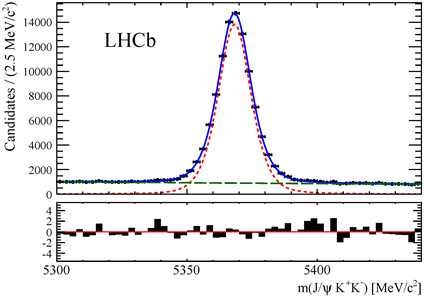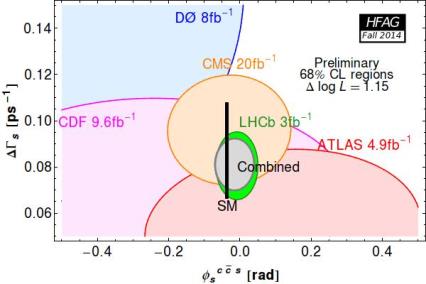Final run 1 result: φs = – 0.010 ± 0.039 rad
Today, at the workshop “Implications of LHCb measurements and future prospects” at CERN, LHCb physicists have presented their final run 1 results of their analysis of the phase φs (the Bs CP-violating phase, for experts), see 27 August 2011, 5 March 2012 and 3 March 2013 news for introduction. The measurement of φs is one of the most important goals of LHCb experiment.
The value of φs is precisely predicted in the Standard Model and sets the scale for the difference between properties of matter and antimatter for Bs mesons, known to physicists as CP violation. The predicted value is small and therefore the effects of New Physics could change its value significantly.
In the CP violation that drives φs the role of Bs oscillations (3 March 2013 news) is very important. Here the Standard Model predicts very small effects, thereby allowing New Physics to manifest itself. This is to be contrasted with other manifestations of CP violation in the Bs system, unaffected by oscillations, where the Standard Model expects large signatures. Such a signature was already observed by LHCb, see 24 April 2013 news.
The 96 000 B0s → J/ψ K+K– decays collected during 2011 and 2012 data taking periods were used in the analysis. The left image shows the J/ψ K+K– invariant mass spectrum. The very clean enhancement at the B0s mass is clearly seen.
The right image shows that the K+K– invariant mass spectrum is dominated by the presence of the φ meson resonance at a mass of 1020 MeV. The φ mesons, and similarly the J/ψ and ϒ mesons, are sometimes called heavy photons since they have the same quantum numbers as the photon. In their analysis LHCb physicists took into account different polarization states of the φ meson in analogy to different photon polarization states. For the first time, the phase of φs is measured independently for each polarization state of the K+K– system. No significant difference is observed between the different polarisation states.
The result φs = – 0.058 ± 0.049 ± 0.006 rad is the most precise measurement of φs to date. Recently the LHCb Collaboration has reported the final run 1 measurement of the φs using B0s → J/ψ π+π– decays, φππs = + 0.070 ± 0.068 ± 0.008 rad, consistent with the φs measurement reported above. The results from the two analyses have been combined giving the final value of φs = – 0.010 ± 0.039 rad. This is the most precise value of φs and is consistent with the Standard Model prediction of φs = – 0.0363 ± 0.0013 rad. The parameter region in which New Physics could still hide is now even smaller than before.
The LHCb today’s result has been included in the HFAG world combination. The φs results of different experiments are shown in the image together with the ΔΓs variable (see 5 March 2012 news for introduction). The green ellipse in the center represents the LHCb result and the grey ellipse shows the world average. The result of the first φs measurement in the Bs → Ds+Ds– decays φs = + 0.02 ± 0.17 ± 0.02 rad is also included in the LHCb combination shown in the image.
Read more in the LHCb workshop presentation and in the LHCb publication.
click the images for higher resolution



